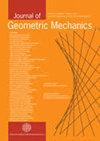伴随轨道网络:从几何到统计力学
IF 1
4区 数学
Q3 MATHEMATICS, APPLIED
引用次数: 1
摘要
在几何力学的框架下,导出了一类具有对称群$G$的网络模型,该网络模型是统计力学中经典海森堡模型的推广。我们考虑了两种自旋耦合方式:一种是动量耦合,另一种是位置耦合,并利用能量-卡西米尔方法详细研究了平衡解及其相应的非线性稳定性。然后,我们以$G=SO(3)$为例,发现动量耦合系统简化为具有大质量自旋的经典Heisenberg模型,而位置耦合情况简化为具有与重顶相似的破缺对称群$SO(3)/SO(2)$的新系统。在后一种系统中,我们在数值上观察到一类初始条件下有趣的类似同步的现象。加入一种保留网络模型共伴随轨道的噪声和耗散,我们发现不变测度由吉布斯测度给出,温度的概念由此定义。然后,我们在重顶状晶格模型中观察到令人惊讶的“三驼峰”相变,随着温度的升高,自旋在失去磁化之前从一个平衡位置切换到另一个平衡位置。这项工作只是将几何力学与统计力学联系起来的第一步,还有几个有趣的问题有待进一步研究。本文章由计算机程序翻译,如有差异,请以英文原文为准。
Networks of coadjoint orbits: From geometric to statistical mechanics
A class of network models with symmetry group $G$ that evolve as a Lie-Poisson system is derived from the framework of geometric mechanics, which generalises the classical Heisenberg model studied in statistical mechanics. We considered two ways of coupling the spins: one via the momentum and the other via the position and studied in details the equilibrium solutions and their corresponding nonlinear stability properties using the energy-Casimir method. We then took the example $G=SO(3)$ and saw that the momentum-coupled system reduces to the classical Heisenberg model with massive spins and the position-coupled case reduces to a new system that has a broken symmetry group $SO(3)/SO(2)$ similar to the heavy top. In the latter system, we numerically observed an interesting synchronisation-like phenomenon for a certain class of initial conditions. Adding a type of noise and dissipation that preserves the coadjoint orbit of the network model, we found that the invariant measure is given by the Gibbs measure, from which the notion of temperature is defined. We then observed a surprising `triple-humped' phase transition in the heavy top-like lattice model, where the spins switched from one equilibrium position to another before losing magnetisation as we increased the temperature. This work is only a first step towards connecting geometric mechanics with statistical mechanics and several interesting problems are open for further investigation.
求助全文
通过发布文献求助,成功后即可免费获取论文全文。
去求助
来源期刊

Journal of Geometric Mechanics
MATHEMATICS, APPLIED-PHYSICS, MATHEMATICAL
CiteScore
1.70
自引率
12.50%
发文量
23
审稿时长
>12 weeks
期刊介绍:
The Journal of Geometric Mechanics (JGM) aims to publish research articles devoted to geometric methods (in a broad sense) in mechanics and control theory, and intends to facilitate interaction between theory and applications. Advances in the following topics are welcomed by the journal:
1. Lagrangian and Hamiltonian mechanics
2. Symplectic and Poisson geometry and their applications to mechanics
3. Geometric and optimal control theory
4. Geometric and variational integration
5. Geometry of stochastic systems
6. Geometric methods in dynamical systems
7. Continuum mechanics
8. Classical field theory
9. Fluid mechanics
10. Infinite-dimensional dynamical systems
11. Quantum mechanics and quantum information theory
12. Applications in physics, technology, engineering and the biological sciences.
 求助内容:
求助内容: 应助结果提醒方式:
应助结果提醒方式:


